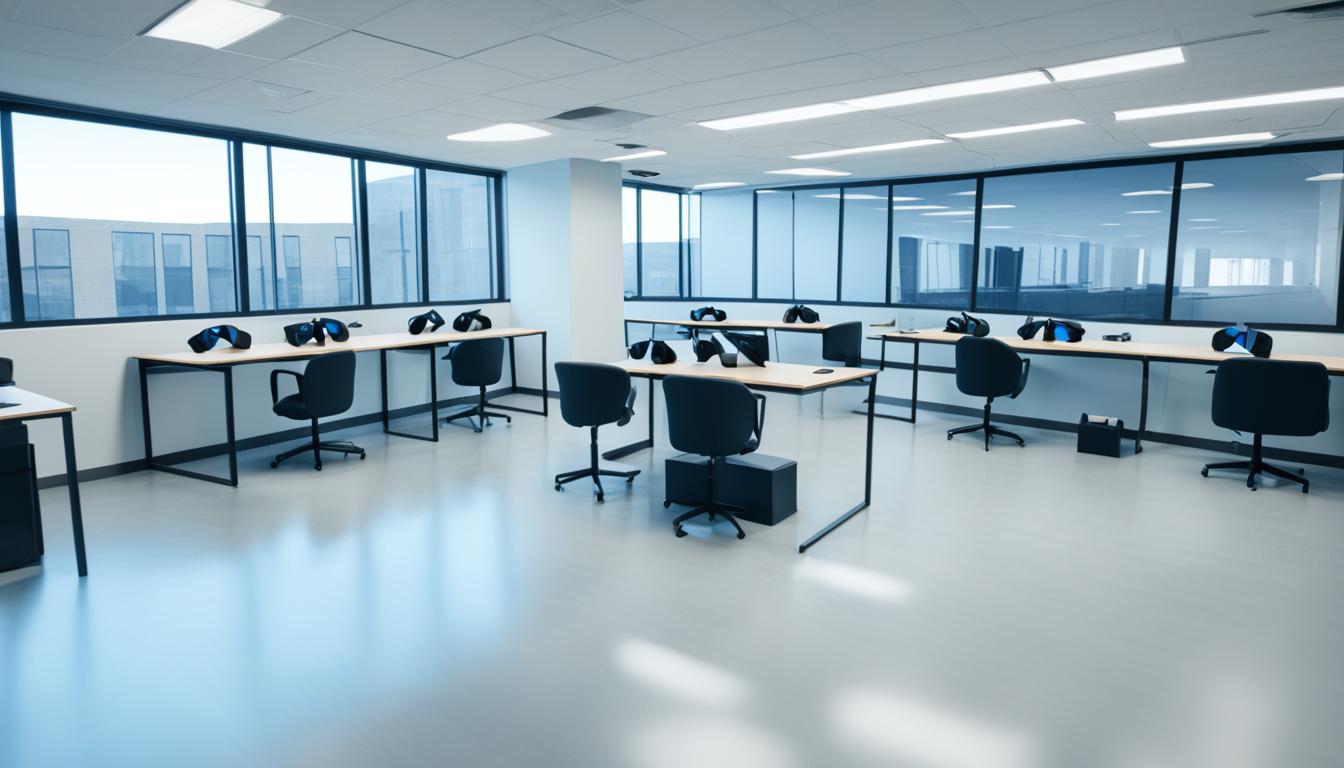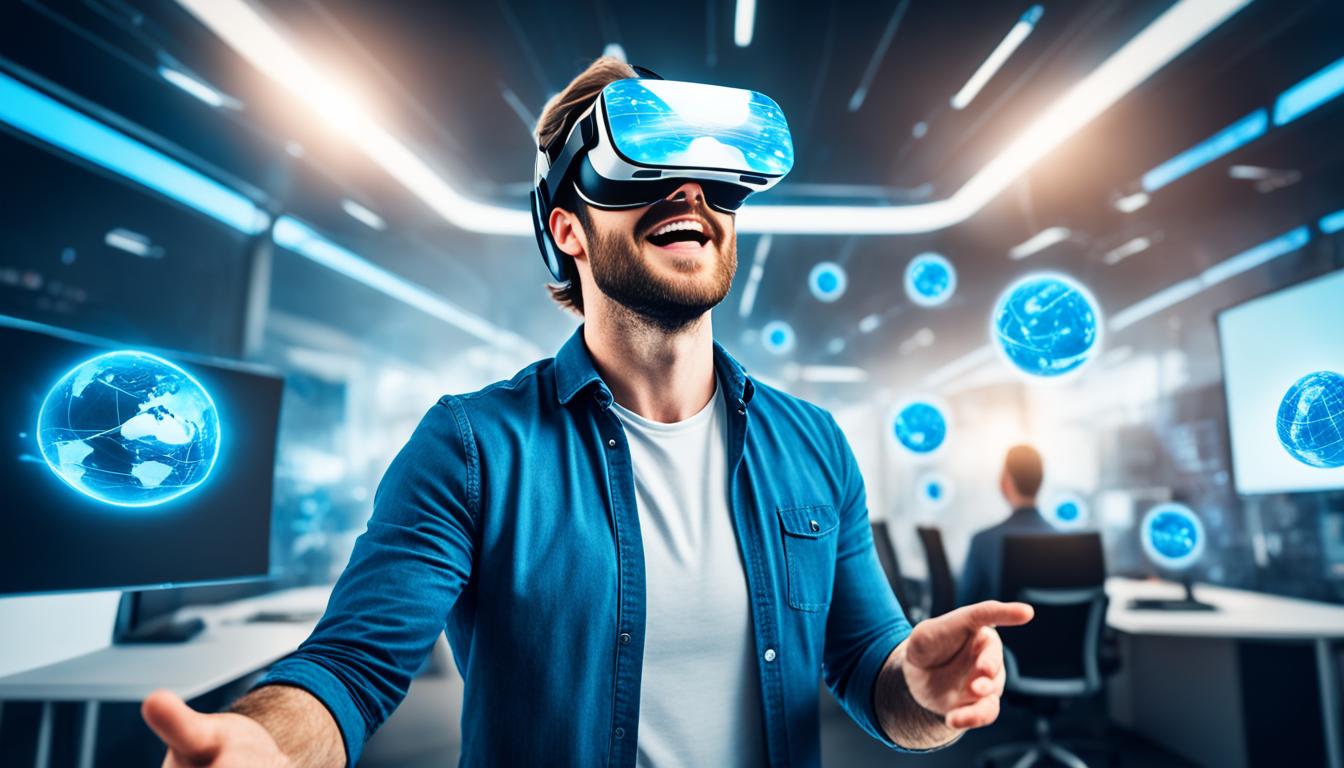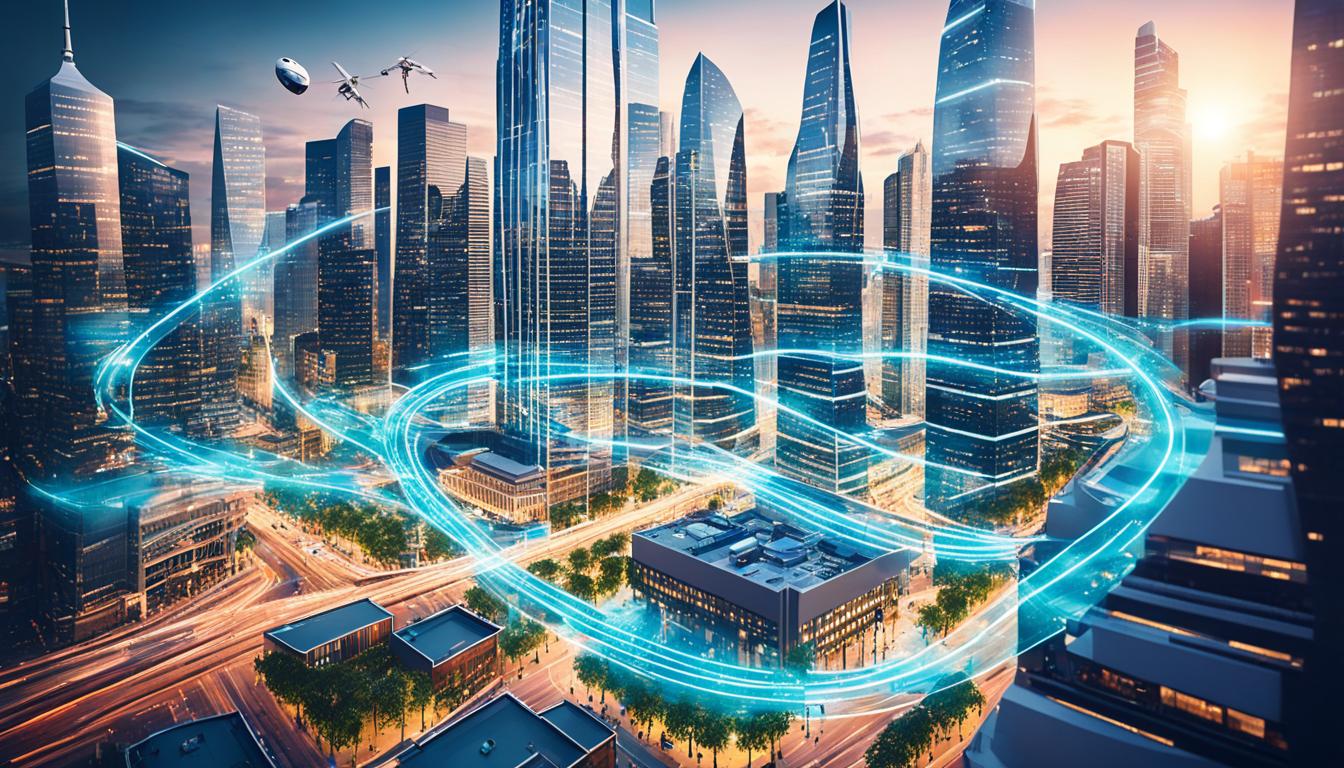Last Updated on December 9, 2025
The rapid growth of Virtual Reality (VR) technology is reshaping the remote work landscape. It’s not just about working from home; it’s about creating immersive experiences that boost productivity and team spirit. This technology bridges the gap between traditional communication, making remote work not only efficient but also engaging and fun.
VR is transforming how we meet and collaborate, from virtual team-building to enhancing creativity. With VR work becoming more prevalent, 56% of businesses now incorporate it into their operations. This shift highlights VR’s role in revolutionizing remote work, marking it as a pivotal innovation for the future of employment.
Key Insights
- Virtual Reality creates immersive environments for effective remote collaboration.
- Enhanced communication and engagement are key benefits of VR work.
- VR technology helps reduce “Zoom fatigue” by providing interactive team connections.
- Many industries are utilizing VR for training, design, and employee onboarding.
- With continued adoption, VR is set to revolutionize workplace dynamics further.
- Companies are establishing virtual break rooms for casual employee interactions.
The Rise of Remote Work
Remote work has surged in popularity, especially post-COVID-19. It started in the 1970s but gained traction in the 1990s with the advent of the internet and personal computers. Now, flexible work arrangements are commonplace, not just an option. Statistics show that in 2019, 26.7% of workers were remote, jumping to 46.6% in April 2020.
Companies are embracing remote work for its benefits, leading to a shift towards flexible schedules. This change opens up a wider talent pool, boosts employee happiness, and reduces data breaches for secure platforms. Prioritizing data security in remote setups ensures a safer work environment.
Technology advancements, like virtual reality, are set to improve remote work further. Major tech firms are investing heavily, hinting at a future where work is more immersive and collaborative. Employees favor hybrid models that combine remote and in-office work, reflecting the dynamic nature of today’s work environments.
What is Virtual Reality?
Virtual Reality (VR) is a cutting-edge technology that creates a simulated environment for users to experience immersive worlds. By donning a VR headset, users enter a digital domain, where they can navigate through vast spaces and interact with virtual objects and avatars. This immersive quality of VR makes it invaluable in fields like education, training, and healthcare.
VR differs significantly from augmented reality (AR), which blends digital elements with the real world. VR, on the other hand, replaces your actual environment with a simulated one. This distinction is key to grasping how VR can revolutionize how we interact at work. The journey of VR began in the 1960s and has since evolved into complex systems with motion tracking and haptic feedback.
VR encompasses various types, including non-immersive, semi-immersive, and fully immersive. Each type offers different levels of interaction and immersion. Fully immersive VR provides a 360-degree experience that mirrors your movements, ensuring the highest level of engagement through sophisticated hardware like spatial audio, motion sensors, and position tracking systems.
VR technology finds applications in numerous sectors. It ranges from architecture visualizations to healthcare simulations, continually expanding its potential for personalized and engaging experiences. VR offers groundbreaking solutions that improve collaboration, streamline training, and create unique interactions in various work settings. As VR technology advances, its potential in the workplace seems boundless.
Understanding Virtual Reality Technology in the Workplace
Virtual reality technology is revolutionizing the workplace, improving training, collaboration, and engagement. It’s crucial to grasp how VR headsets work and the distinctions between tethered and mobile VR. This knowledge offers deep insights into this cutting-edge technology and its impact on your organization.
How VR Headsets Function
VR headsets immerse users in a new world by placing screens right in front of their eyes, creating a three-dimensional environment. They combine visual and sensory inputs to simulate a different reality. With sensors and cameras tracking head movements, users can move through the virtual space naturally. Companies like Oculus and HTC have significantly improved VR headsets, highlighting their role in workplace technology.
Types of Virtual Reality
Knowing the different types of virtual reality can help you choose the right solution for your organization. There are three primary categories:
- Tethered VR: This type connects to a computer, ensuring high graphics quality and a more immersive experience. It is ideal for detailed simulations and intense training scenarios.
- Mobile VR: Operated through smartphones, this option is more accessible as it is convenient and portable. Mobile VR is suitable for basic training programs and experiences.
- Standalone VR: These headsets come with built-in hardware, eliminating the need for external devices. They offer a middle ground between tethered and mobile solutions, allowing flexibility in various training environments.
Benefits of Virtual Reality Work
Integrating virtual reality (VR) into the workspace offers numerous advantages that transform the way you approach remote work. The benefits of VR work extend beyond novelty, enhancing collaboration and communication while increasing overall engagement among team members.
Enhanced Collaboration
With virtual reality, teams can collaborate in immersive environments, mimicking face-to-face interactions despite physical distances. This technology creates shared virtual spaces where brainstorming and problem-solving flourish. Engaged team members can manipulate 3D models and participate in interactive discussions, making collaborative efforts feel more dynamic and effective.
Enhanced collaboration not only streamlines productivity but also fosters a stronger sense of unity within the team.
Improved Communication
Improved communication in remote settings becomes a reality through VR’s advanced capabilities. Features such as spatial audio and lifelike avatars enrich the interaction, providing a more engaging experience compared to traditional video conferencing tools. Clearer communication helps prevent misunderstandings and promotes effective exchanges of ideas, thereby enhancing teamwork and cooperation.
Increased Engagement
Users report that immersive environments significantly boost engagement levels. Virtual reality captivates attention and encourages participation, making it an excellent tool for meetings and presentations. This heightened engagement leads to improved retention of information and encourages active involvement, ultimately resulting in better work outcomes.
When you immerse yourself in a virtual realm, the learning experience transforms into something entertaining and memorable, which keeps you coming back for more.
Applications of VR for Job Training
Virtual Reality (VR) has revolutionized job training, offering companies innovative ways to boost employee skills. Through VR, organizations can craft realistic job simulations and immersive training environments that mimic real-world situations. This method speeds up learning and lets employees hone their skills in a secure, controlled environment.
Realistic Job Simulations
VR’s key benefit in job training is its ability to simulate real job tasks. Research indicates that VR learners finish training four times quicker than those in traditional classrooms. Employees can tackle simulated tasks from various fields, gaining practical experience without the risks of on-the-job training. Over 1 million employees have profited from such programs, highlighting VR’s popularity in training.
Industry-Specific Training Environments
Diverse industries have adopted VR for specialized, immersive training. In healthcare, VR plays a crucial role in infection-reduction training, especially during the COVID-19 pandemic. Companies like Shift have modified their VR training to align with new challenges, demonstrating a strong commitment to VR in job training. Immersive training environments have shown to be effective for technical skills like data analysis and for enhancing safety awareness in hazardous material handling.
How is VR Used in Remote Work?
Virtual reality (VR) is revolutionizing remote work by enhancing team collaboration, communication, and connection. It creates immersive environments that boost various aspects of remote work, making it essential for today’s businesses.
Virtual Meetings and Conferences
Companies are turning to VR for virtual meetings, creating spaces that mimic real-life interactions. PricewaterhouseCoopers is pioneering this by developing virtual meeting spaces in the metaverse. These spaces allow for deep, engaging interactions. The Meta Quest 2 and Vive Pro 2 headsets are key tools for these experiences.
Research shows a 16% boost in communication during VR meetings. This technology overcomes remote work challenges like lost non-verbal cues and miscommunication.
Team Building and Social Interactions
VR is becoming a go-to for team-building activities. Platforms like Horizon Workrooms from Meta let users create unique avatars, promoting creative teamwork among remote teams. These immersive settings increase team camaraderie, with a 58% rise in participants feeling closer to colleagues than in traditional video calls.
Engaging in VR team-building exercises builds a strong sense of community and improves teamwork.
Virtual Workspaces
Virtual workspaces are transforming the remote work landscape. Tools like Immersed and vSpatial allow users to set up virtual monitors and collaborative areas. These environments are crucial for maintaining productivity and connection among team members across distances.
A robust fiber internet connection is vital for these experiences, enabling employees to work in innovative, versatile settings.
The Impact of Virtual Reality Work on Business
Virtual reality (VR) is revolutionizing business strategies and boosting workplace innovation. Companies that adopt VR see streamlined processes and better team collaboration. This technology is transforming how businesses operate.
The VR market is booming, growing from under $12 billion in 2022 to a forecasted $22 billion by 2025. This growth shows a strong interest in VR for training and development. Experts believe 70% of professionals support its use. As VR becomes more affordable, more industries can access it, leading to business transformation.
VR training has shown significant benefits, like a 43% drop in workplace injuries. Companies like Osso VR are leading in virtual surgical training, making healthcare safer and more efficient. Automotive firms also use VR for design reviews, cutting costs and improving global teamwork.
With 60% of employees wanting VR headsets at work, the technology’s appeal goes beyond entertainment. It helps reduce travel, improve training, and boost employee satisfaction. The potential for higher productivity and profits makes VR an attractive investment for companies.
The future of business heavily depends on VR technology. By embracing this innovation, companies can create a dynamic, engaging workplace that suits a diverse workforce.
Challenges and Considerations in VR Adoption
Embracing virtual reality (VR) technology comes with numerous challenges for organizations. It’s essential to understand these hurdles to effectively navigate the complexities of VR adoption.
Cost and Accessibility
The high cost of VR technology is a major hurdle for many businesses. Top-tier VR equipment is expensive, making it inaccessible to smaller organizations. Additionally, ongoing maintenance and software development costs add to the financial burden. This financial aspect can make the initial investment in VR daunting, despite its potential long-term benefits.
Learning Curve for Employees
Employee training is a critical aspect of VR adoption. Workers must adapt to new tools and environments, which can be challenging. The learning curve is steep, often taking employees longer to master VR applications than traditional methods. For instance, teaching a nurse a task in real life takes about 3 minutes, but in VR, it can take 3 to 4 times as long. To overcome these challenges, organizations must invest in thorough training and continuous support for a smoother transition.

Future of Virtual Reality in Employment
The evolution of technology is reshaping the employment landscape. Virtual reality (VR) is set to expand its reach, moving beyond current applications. Companies are now exploring the innovative uses of VR to enhance various workforce aspects. This integration not only boosts training and skill development but also creates more engaging experiences for employees.
Expanding Applications Beyond the Current Use
With 56% of businesses already using VR or AR, the potential for growth is vast. Your organization can leverage VR for advanced training that mimics real-life scenarios. Here are some exciting prospects for VR in employment applications:
- Remote onboarding: VR can provide immersive tours and training, making new hires feel welcomed and informed in virtual environments.
- Employee wellness: Innovative uses of VR can facilitate mindfulness sessions and stress management programs, contributing to a healthier workplace culture.
- Customer engagement: Businesses can utilize VR to create interactive experiences that captivate customers and facilitate better understanding of products and services.
- Improved collaboration: Virtual meetings and team-building activities can be drastically enhanced through vivid simulations and interactive environments.
As VR headset technology advances, with better resolutions and data transfer rates, these trends will likely expand. In the next decade, VR could change how we collaborate and communicate, leading to more effective and engaging remote and hybrid work environments.
Conclusion
Reflecting on the *transformative potential of VR*, it’s clear that this technology is revolutionizing remote work. It not only overcomes distance barriers but also creates a more inclusive space for team collaboration. VR enhances communication, boosts creativity, and offers a dynamic work experience in today’s digital age.
VR technology’s growth is marked by high-resolution displays, advanced motion tracking, and haptic feedback. Companies like Talespin and Kokowa are at the forefront, offering immersive training and tools for creating virtual spaces. As healthcare and education sectors adopt these innovations, the professional landscape is set to change significantly.
Looking ahead, VR is set to play a crucial role in the future of work. By embracing the *benefits of VR work*, companies can lead in workplace innovation. This technology allows you to adapt to changing work demands and create experiences that are enriching, engaging, and transformative.








